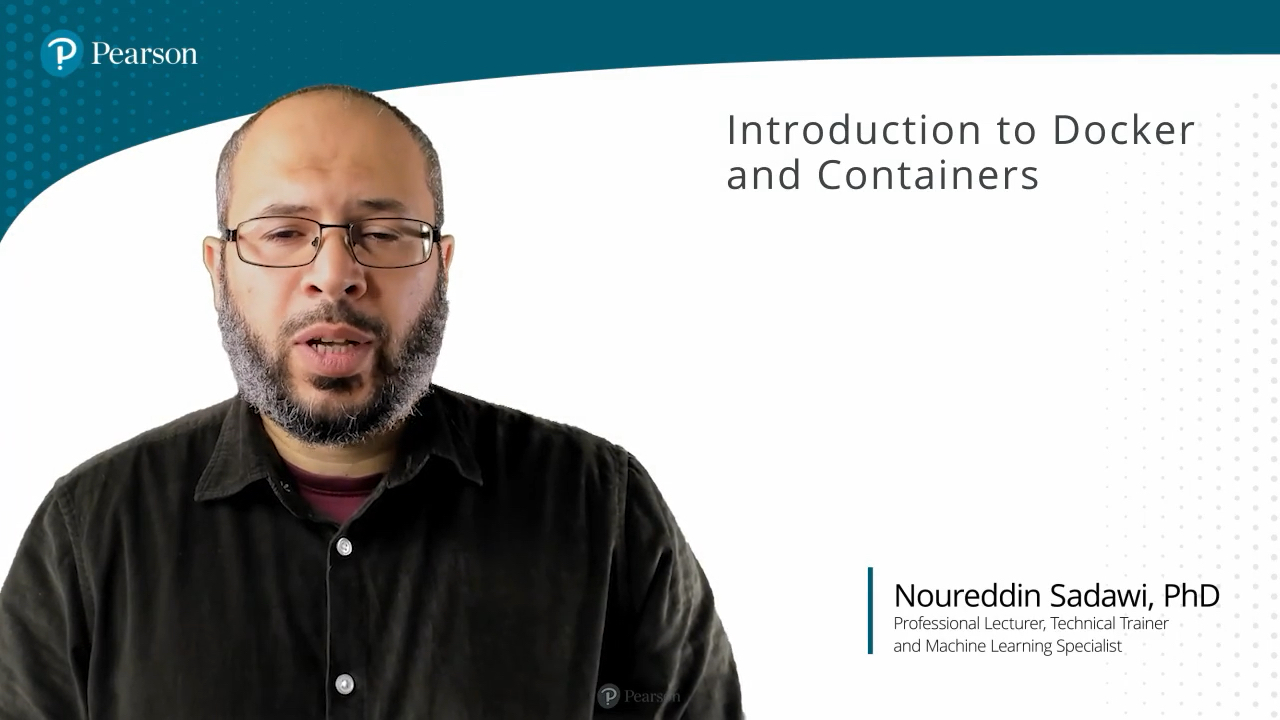Introduction to Docker and Containers (Video Course)
- By Noureddin Sadawi
- Published Nov 9, 2023 by Addison-Wesley Professional.
Online Video
- Your Price: $239.99
- List Price: $299.99
- About this video
Video accessible from your Account page after purchase.
Register your product to gain access to bonus material or receive a coupon.
Description
- Copyright 2024
- Edition: 1st
- Online Video
- ISBN-10: 0-13-817435-0
- ISBN-13: 978-0-13-817435-4
Est 5+ Hours of Video Instruction
Docker containers have become the most common part of the process of packaging up and deploying applications. Large-scale technology giants such as Amazon, Google and Microsoft rely on them so developers need to understand how to use containerize.
A Docker container is a lightweight, standalone, executable package of software that includes everything needed to run an application: code, runtime, system tools, system libraries and settings. Docker streamlines the development lifecycle by allowing developers to work in standardized environments using local containers which provide your applications and services. Containers are great for continuous integration and continuous delivery (CI/CD) workflows.
In this course, Noureddin introduces Docker and containerization technology, why it is useful, and what the clear benefits are. He covers how to install Docker, how to run containers successfully, and how to professionally containerize applications with Dockerfile. This course offers a glimpse into real-world applications to show how the containerization and deployment process works.
Skill Level:
Beginner to Intermediate
What You Will Learn:
Developers and Engineers will learn how to:
- Understand how and why Docker is essential to software development and deployment.
- Learn the difference between containers and VMs and why containers are the preferred option.
- Professionally dockerize your applications and add features to them.
- Run docker containers smoothly and seamlessly.
- Maximize usage and minimize errors by avoiding the dependency hell problem via docker containers.
Who Should Take This Course:
Job titles:
- Software developers and engineers
- DevOps engineers and security specialists
- Machine Learning Engineers
- Technical and software project managers
Course Requirements:
Familiarity with command-line (e.g., terminal). Familiarity with software installation. Familiarity with Ubuntu Linux (recommended, not required)
About Pearson Video Training
Pearson publishes expert-led video tutorials covering a wide selection of technology topics designed to teach you the skills you need to succeed. These professional and personal technology videos feature world-leading author instructors published by your trusted technology brands: Addison-Wesley, Cisco Press, Pearson IT Certification, Prentice Hall, Sams, and Que. Topics include IT Certification, Network Security, Cisco Technology, Programming, Web Development, Mobile Development, and more. Learn more about Pearson Video training at http://www.informit.com/video.
Video Lessons are available for download for offline viewing within the streaming format. Look for the green arrow in each lesson.
Sample Content
Table of Contents
Introduction
Lesson 1: Background on Docker and Containers
1.1 Learn what Docker is and what Containers are
1.2 Review the Dependency Problem before and after Docker
1.3 Compare Containers with Virtual Machines
1.4 Find out why Containerization has become popular
1.5 Use Docker for microservices and reproducibility
Lesson 2: Docker Installation
2.1 Learn the Docker Architecture
2.2 Perform Docker Installation on MacOS
2.3 Docker Installation on Windows
2.4 Docker Installation on Linux
Lesson 3: Docker Containers
3.1 Run your first Docker containers
3.2 Run your Docker containers in the background
3.3 Learn Docker container networking
3.4 Create a Docker-Hub account
Lesson 4: Docker Containers Versus Images
4.1 Understand the difference between Docker containers and images
4.2 Search for Docker images on Docker-Hub
4.3 Learn the difference between Docker-Hubs root namespace and user namespace
4.4 Learn about self-hosted namespace
Lesson 5: How to Dockerize Applications (Create Your Own Docker Images)
5.1 Develop an understanding of how to create Docker images
5.2 Create a Docker image interactively
5.3 Learn the structure of a Dockerfile
5.4 Create a Dockerfile to automatically create a Docker image
Lesson 6: Learn Docker Volumes and More on Dockerfile
6.1 Learn and use Essential Dockerfile instructions
6.2 Learn and use Docker Volumes for permanent data storage
6.3 Learn more useful Docker commands and Dockerfile instructions
Lesson 7: Create Real-World Docker Applications
7.1 Dockerize a Python Machine Learning Application
7.2 Dockerize a Javascript Web Application
7.3 Dockerize an R application
7.4 Learn Windows Containers
Lesson 8: Run Multi-Container Apps with Docker-Compose
8.1 Overview of Docker-Compose and Docker Networking
8.2 Develop an understanding of Docker-Composes YAML configuration
8.3 Learn how to create a service
8.4 Learn how to work with environment variables, scaling and replicas
8.5 Create a real-world example with Docker-Compose
Course Summary
More Information

